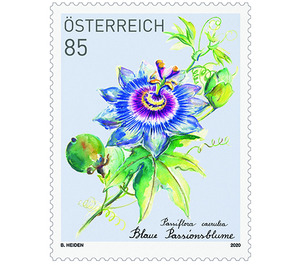Loyalty bonus stamp 2019 – blue passionflower - Austria 2020 - 85 Euro Cent
Theme: Flora
| Country | Austria |
| Issue Date | 2020 |
| Face Value | 85.00 |
| Edition Issued | 300,000 |
| Color | green blue |
| Stamp Type | Commemorative |
| Item Type | Stamp |
| SID | 537519 |
| Dimensions | 42.00 x 33.35 |
| In 18 Wishlists | |
A climbing beauty An especially decorative and colourful bloom adorns this year’s loyalty bonus stamp: Austrian Post is thanking its subscribers for their loyalty with the opulent blue passionflower. The blue passionflower (Passiflora caerulea) is native to parts of Argentina and Brazil. In our latitudes it is mostly found as a house-plant or on balconies. However, in locations where the climate is favourable it can also overwinter in the garden, because even if what is visible above ground dies off, the plant will grow back from the roots in the spring. The blue passionflower needs plenty of sun and warmth, as well as a support to climb up, because if the conditions are just right this attractive climbing plant can grow to be several metres tall. It is not just the dark, lobed leaves, but above all the striking, fragrant blooms that make this variety of passionflower so spectacular. The first blueish-white, symmetrical blooms, which can reach up to ten centimetres across, start to appear as early as late spring, and with the right conditions the plant will continue to flower right through until the autumn. The ten petals are covered by delicate blue-, white- and purple-coloured coronal filaments, from which five green stamens and three purple stigma protrude. The blue passionflower is cultivated in many colour variants as a popular cultivated plant. When they ripen, the fruits of the blue passionflower are a brilliant orange. The red berries inside them are edible, but have a bitter, acidic taste. What we know as passion fruit are the much tastier fruits of another variety, the Passiflora edulis. Symbolic meaning The passionflower owes its name to the striking appearance of its flowers, which are interpreted as symbolising Christ’s passion. The various parts of the plants are meant to symbolise Christ’s sufferings, with the coronal filaments, for example, symbolising the crown of thorns and the winding tendrils, the scourge. In the language of flowers the passionflower represents profound faith. However, in keeping with the “passion” in its name, the passionflower can also be seen as a symbol of the passion with which philatelists collect stamps.


